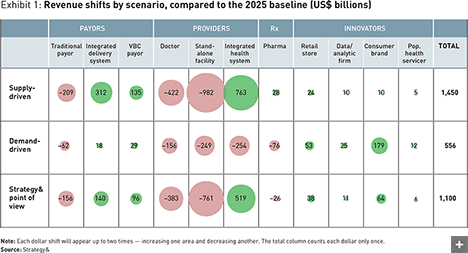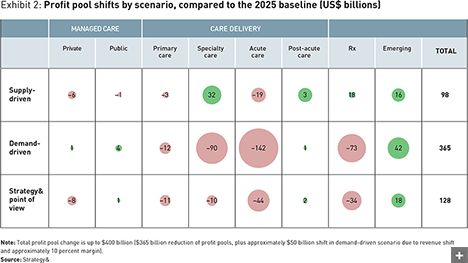The Coming $1.5 Trillion Shift in Healthcare
A comprehensive model shows how far-reaching trends in the massive industry will influence the growth of profit pools — and how payors and providers should respond.
The U.S. healthcare market is in the midst of unprecedented changes. Major payors, health systems, and other providers are consolidating in megadeals aimed at generating scale and wringing inefficiencies out of the system. Consumers are increasingly employing the growing array of digital apps, wearables, and other technology in order to play a more direct role in their own care. And extensive government reforms are changing the way care is delivered, assessed, and paid for. In this context, management teams may have difficulty making strategic plans for next month, let alone next year.
These shifts have significant financial implications. By 2025, some US$1.5 trillion in annual revenue (more than one-third of total industry sales) will change hands across the U.S. healthcare industry, with a corresponding shift of nearly $400 billion in profits (roughly one-quarter of the industry total). To position themselves to capitalize on the shifting profit pools, management teams need to start engaging in scenario planning, assess how various shifts will play out, and determine the implications for their company’s bottom line. In other words, they need to distinguish signal from noise.
Over the past few years, we have developed a proprietary model to project how healthcare profit pools would change by 2025. In an earlier article for strategy+business, we discussed our original findings from this model. Updates and refinements have led us to a clearer understanding of the potential shifts and underlying opportunities for both payors and providers. The model examines key trends in the industry and how they might affect the way patients receive care — including healthcare volume, price, and cost. We also surveyed key decision makers among payors, providers, and employee groups, and conducted focus groups with senior executives. Using this information, we made estimates regarding how the trends would play out, and then ran simulations to determine the most probable outcomes. That led to three potential end-state scenarios for the U.S. healthcare market in 2025: supply-driven, demand-driven, and equilibrium (see Exhibits 1 and 2). Each, in turn, points to strategic responses that companies should consider.
Supply-driven. The “supply-driven” scenario assumes that providers have the biggest impact in reshaping the healthcare system, through more integrated and coordinated care. Payors and providers continue to consolidate in order to manage populations and offer more coordinated, integrated care while also capturing scale efficiencies. A smaller number of players increase their market share and retain greater pricing power. Risk shifts from payors to providers, the pharmaceuticals industry gains (primarily due to better adherence driven by coordinated care), and payor margins shrink. In our analysis, the supply-driven scenario creates roughly $360 billion in value, primarily by reducing costs from today’s levels. More than 90 percent of current profits will accrue to a few integrated players.
Demand-driven. The “demand-driven” scenario assumes that changes on the patient side will dominate. As consumerization prevails, patients take a more direct role in their own care, and pay a larger share of costs out of pocket. As a result, they increasingly seek out efficient new solutions, and they rely on technology to manage their care more directly, along with alternative care settings and other tools. The solutions with the biggest impact come from areas outside the traditional healthcare industry, such as software, telecom, retail, and apparel companies. Utilization improves, but intense competition leads to lower prices and reduced margins among incumbent providers. Those incumbents also lose ground to startups that can create better consumer experiences and incentives for consumers to manage their own health. Non-acute care moves out of traditional settings and into retail environments. And an increased government share of health spending puts downward pressure on pharma prices. The demand-driven scenario unlocks roughly $480 billion in new value by 2025 — again by reducing costs from current spending levels. Notably, the demand-driven scenario creates roughly 35 percent more value than the supply-driven scenario.
Equilibrium. Both the supply- and demand-driven scenarios are hypotheticals that assume one model will dominate. And both are ultimately unsustainable, because neither would lead to a stable, end-state market. The supply-driven scenario would fail to slow increases in healthcare costs — because a smaller number of players would retain greater control over access and pricing — and would likely trigger the next revolution of reform and restructuring to make healthcare more sustainable. And the demand-driven scenario would erode profit margins for providers beyond sustainable levels, likely causing key participants to exit the market.
Accordingly, we believe the healthcare market of 2025 will likely resemble an equilibrium scenario, in which elements of both the supply-driven and demand-driven scenarios coexist in a state of dynamic tension. Cost pressures, market shifts, and new technology combine to bend the cost curve. Payors and providers (including pharmaceutical companies) slowly shift to value-based care, while still protecting their profit pools. Our analysis shows that the equilibrium scenario will unlock more than $450 billion in new value by reducing costs and reallocating profits among both current incumbents and new market entrants.
Ways to Play
Given the tremendous value at stake, and the speed at which changes are taking place, we have described the current upheaval in the healthcare industry as a kind of gold rush. And the professionals who move quickly to stake their claims can strike rich veins of profits. There are three clear strategies that companies can pursue to reduce medical spending, partner with technology-empowered consumers, and improve outcomes: They can position themselves as gold miners, bartenders, or railroad pioneers.
Gold miners are vertically integrated players, either payors or providers, that create medical value by digging deep into data to improve outcomes and share in the savings. The gold miner model involves developing measures to manage the health of specific populations, particularly patients with complex, chronic diseases such as diabetes, cancer, or heart disease. Geisinger Health System, a large, integrated provider in Pennsylvania, uses remote monitoring and other communication channels to help chronically ill patients. Geisinger says that these measures have reduced hospital admission rates by 18 percent, readmission rates by 31 percent, and total spending by 7 percent.
By contrast, bartenders engage consumers directly. They provide a service, offer information and advice, and empower consumers to take a more direct role in their own wellness and care. Bartenders, who emphasize convenience and a positive customer experience, are typically new entrants, and often hail from non-healthcare sectors such as software, retail, electronics, and apparel. For example, Walmart and Target now offer walk-in clinics that can provide efficient care for minor health issues. Similarly, walk-in urgent-care clinics are offering speedy and convenient access to non-acute care.
Railroad pioneers are a third category of business model that can thrive in the new healthcare environment. These companies may not deal with consumers in any direct way, but they provide the technological foundation for new service offerings from bartenders and gold miners, through either data infrastructure, new technological platforms, or measures aimed at eliminating bottlenecks. They can streamline the financial or data aspects of healthcare, frequently by developing systems and solutions that can bridge the gaps among organizations that have different technology standards.
For example, Augmedix is a documentation application that speeds paperwork during clinical visits. The service uses Google Glass for physicians along with powerful speech-to-text tools to automatically fill in electronic health records (EHRs). Similarly, Microsoft’s Health Vault is trying to establish itself as a universal EHR that consumers can use to centrally store all their medical information, which they can then share with providers at their discretion.
The Stakeholder Response
Our emerging understanding of the shifting profit pools in healthcare has clear implications for healthcare companies — both incumbents and new entrants. First, companies need to be clear on how they create value. For established payors and providers, that could mean employing gold-miner approaches in order to manage specific populations, deliver better outcomes, and reduce the cost of care. For new entrants, it could mean following the bartender approach and rolling out digital tools and other offerings that help consumers directly manage their own wellness and care.
Second, companies need to take into account the competitive dynamics of the industry today, and model how those elements might change in their local markets, in order to capture as much new value as possible. This can be a regular strategy exercise in which management teams make specific projections — dialing up or down various aspects of the model to assess how those shifts change the financial landscape. For example, what happens if consolidation among payors and providers accelerates? What happens if primary care shifts to virtual settings faster than anticipated, or more slowly? What happens if employers continue to dominate the market for health insurance? How will these shifts and potential scenarios impact profit pools for the industry, along with the company’s profit margins?
Very likely, this kind of scenario-planning exercise will point to specific actions that companies need to take, such as reallocating assets to R&D, increasing the pace of acquisitions or divestments to reshape the portfolio, or investing in new capabilities.
Third, regulators have a clear set of imperatives as well. They should look for ways to thoughtfully phase out the current fee-for-service model for government-sponsored care. That entails balancing efforts among both consumers and providers. On the consumer side, regulators should seek to increase transparency and apply behavioral economics in order to influence consumers and providers to change specific behaviors. For example, well-designed incentives for people to lose weight, stick to their medication schedule, or exercise can lead to greater long-term payoffs. And on the provider side, regulators should expand beyond pilot tests to broader initiatives that emphasize value-based care. More broadly, the government can spur the adoption of promising new technologies such as EHRs and telemedicine by developing interoperability standards. It doesn’t need to pick winners, but it can establish a level playing field and speed the adoption of new ideas that have already proven their value.
Staking Their Claim
The changes we describe aren’t theoretical. In fact, the transition is well under way. Already, many companies are tapping into changes in both supply and demand and rolling out new business models. For instance, many incumbent payors and providers are currently applying gold-miner strategies to improve the delivery of care through value-based contracting, streamlining of inefficiencies, and similar initiatives. Take Banner Health Network, a Phoenix-based accountable care organization (ACO) that treats 61,000 Medicare and Medicaid patients. By focusing on coordinated, outcomes-based care — rather than a series of individual, isolated procedures — Banner has reduced its total cost of care by 5 percent while improving its quality ratings. Banner is now in its third year as an ACO, and it has refined its approach over time, with a strong focus on IT and population management.
The changes we describe aren’t theoretical. In fact, the transition is well under way.
Other incumbents are employing bartender strategies. For example, UnitedHealthcare is rolling out a new business unit called Harken Health, which focuses on wellness and prevention through what it calls “relationship-based primary care.” Harken is opening a network of 10 health centers in Atlanta and Chicago that members can visit for free physicals, along with classes in such areas as fitness, nutrition, yoga, and strength training. Each customer gets a care team with a clinician, a health coach, and a behavioral health specialist. Patients can schedule same-day appointments or access specialists around the clock through a web portal, phone, email, or video chat. There are no co-pays except for prescription drugs, and Harken customers also get access to 850,000 providers nationwide for more advanced procedures, through UnitedHealthcare’s network. Even though Harken relies on some gold-miner strategies, it is a bartender at its core, appealing directly to consumers and commercializing loyalty and retention.
Similarly, Boston-based Iora offers care through a network of branded primary-care clinics that emphasize patients’ overall health, rather than providing as many procedures as possible. Every patient gets a health coach to coordinate the nonclinical aspects of care. Rather than simply using primary-care physicians as the referral mechanism for more comprehensive services, Iora seeks to engage patients at the primary-care level, particularly for complex, chronic, or lifestyle diseases such as diabetes, obesity, and heart disease. By addressing these issues as early as possible, Iora can help patients avoid more expensive procedures later on.
Iora also uses health coaches to coordinate all the nonclinical aspects of care that can affect patient health (such as diet and even transportation to appointments). The company’s management is trying to strike a balance between standardizing some aspects of care across all locations — for example, the structure of daily meetings, its proprietary EHRs, and office design — while letting offices tailor other elements to the needs of their local patients.
Many new entrants are employing a bartender approach to tap into consumerization. Among payors, Oscar Health is a startup health insurer that is applying data and technology to make insurance far more customer-friendly. Oscar — which has received high-profile investments from VC players, including $32 million from Google Capital — offers an intuitive Web interface, a mobile app, and easy-to-read bills. Customers get unlimited access to physicians through telemedicine (with promised hold times of less than 10 minutes), along with consumer-friendly features such as free fitness tracking devices, no-cost generic drugs, and free wellness checkups. The company also uses analytics to better match patients to physicians. It currently has customers in New York and New Jersey, mostly in younger and healthier demographics, and has recently expanded to California and Texas.
Some of these offerings clearly straddle the line between bartender and gold miner. In addition, larger companies may not have to choose one approach but can instead place multiple bets, using a portfolio strategy in which specific business units offer products/services that appeal to certain customer segments. UnitedHealthcare is a good example. In addition to rolling out the Harken Health clinics discussed above (using a bartender strategy), it has a service called Optum, which offers care management services to providers and mines data for ways to improve the delivery of care. (Underscoring the dynamic nature of the industry, Optum itself recently began hiring its own primary physicians and opening walk-in clinics.)
The evidence is clear that the healthcare market of 2025 will look radically different from today’s. Yet an outline of that market is already emerging. The underlying trends — new technology, consumerization, and an emphasis on medical value — are not going away. Companies face a choice: They can either continue reacting to those trends, or they can understand them and take strategic steps today in order to capitalize. We believe that winning companies will choose the right strategy for their situation, employ elements of both the gold-miner and bartender strategies, and build the right capabilities to support those strategies.
Methodology
In assembling our model, we studied 18 trends in the industry in order to assess the financial implications of various shifts. Of these 18, we determined that a subset accounted for some 95 percent of the medical value to be created by 2025. Specifically:
- Growing power of consumers in healthcare
- Standardized, integrated care, which will increase the efficiency of procedures and create medical value
- Care delivered anytime and anywhere
- Whole-person health, particularly for people with complex, chronic lifestyle diseases such as diabetes, obesity, or heart disease.
For all 18 trends in these four areas, we created a series of projections regarding the speed at which the trends would play out. Then we connected those rates to revenue and profit flows in the industry. To do so, we developed relationships for how changes in each trend would correspond to linear changes in revenues for different activities along the value chain, factoring in volume, price, and cost. (To determine the relationship for each trend, we looked at academic papers, case studies, economic theories, and other models.)
Author profiles:
- Sundar Subramandian is a thought leader in the health and operations practices of Strategy&, PwC’s strategy consulting business, where he works with healthcare clients on designing transformative business models and operational improvement programs and leads the Government Programs Center of Excellence. He is a principal with PwC US, based in New York.
- Jay Godla is an advisor to executives in the health and corporate and business strategy practices of Strategy&, where he works with health services clients on a broad range of issues, including strategy development and strategic planning. He is a principal with PwC US, based in Chicago.
- Christoph Dankert is specialist in the health and technology practices at Strategy&, where he drives the group’s thinking on new business models in the healthcare industry and helps payors improve the operational efficiency of their current businesses. He is a director with PwC US, based in San Francisco.
- Also contributing to this article were Igor Belokrinitsky, principal with PwC US, and Carl Dumont, managing director with PwC US.




